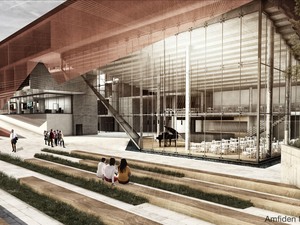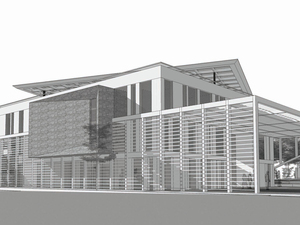Student European Award for Architectural Design Milano 2013
Proje Açıklama MetniThe project proposes a prototype called MIDTERMINAL, basically functioning as a small-scale hub juxtaposing the vehicular transportation with the railway system. The proposal derives its motivation from the existing problems caused by the heavy use of vehicular transportation inbetween the cities and tries to address a possible solution.
Terminals are interaction spaces between the people and the cities. Based upon this conception, the designed structures attempts to add in to the collective memory of the city as a new public interface. Considering the increasing importance of railway transportation, this interface would also act as a small scale transfer terminal between the overland and the railway transport. For many years, overland transportation which was given the priority created many problems. Today, the alternative transportation ways have eased a considerable extend of these problems, especially in the cities. Integrating the railway to the transportation system inbetween the cities in more efficient way would help solving the traffic problems in a greater extend. Integrating these different modes of tansportation in more compact forms would suggest more economical and sustainable solutions especially in Turkey as a country which carries a heavy transit traffic. The easy transfer of passengers and commodities are one of the primary advantages of this proposal, as well as the opportunity to choose between the different modes of transportation whichever would be more advantagious.
Ankara, being the center of railway system in Turkey, is already housing ongoing projects of high-speed train transportation. In this context, along the east-west axis of railway route in Ankara, two small scale junctional bus terminals are proposed in the scope of this project. The one in the west is in Sincan district and the one in the east is in Mamak district. Since Ankara is a city mainly extending along the west-east axis, the main bus terminal “ASTI” is now in the center of the city, creating heavy traffic problems. The proposed stations would not only integrate the bus transportation with the railway system but also relieve the traffic problems caused by the central position of “ASTI”. They would also make the railway transport more comfortable and preferable.
The chosen project area is located in the eastern part of Ankara, in Mamak, in the last station of suburban train route. In the south of the train route, the main intercity highway between Ankara and Samsun is located whereas in the North, the inner city roads are located. As an outcome of this position, the connection of private vehicles an public buses fort he city is to be provided from the north while the connection with the intercity buses is to be provided from the south. The structure of this prototype is based upon a simple diagram. The existing railway line is kept above the ground while the terminal is elongated through the train line on the ground. The structure designed independently from the concrete columns carrying the railway line and forms a helix in the section. With the helix form, the railway line is enclosed within the terminal, steel platforms and glazed facade of the terminal are attached to the tunnel creating a direct relation with the train and the bus station. The end of the helix is enlarged and attached to the ground creating a large canopy acting as a public space. The steel tunnel is designed modular and considered to be able to extend in the case of increasing demands of capacity. Making the use of smooth topography, the entrances and exits are all planned in the ground level. The main entrance of the building in the north establishing a strong visual connection with the other parts of terminal. In the middle axis of the building the ticket offices are located, the administration offices are on the west side whereas cafes are located on the east side. Under the canopy designed in the north entrance of the building, open spaces are proposed in the form of cafes and bus stops. The proposal, suggesting a prototype which would address many of the existing problems, manifests itself a structure of junction between the modes of transportation and the people.


.jpg.jpeg)
.jpg.jpeg)
.jpg.jpeg)
.jpg.jpeg)
.jpg.jpeg)


.jpg.jpeg)


.jpg.jpeg)
%20(1800%20x%201180).jpg.jpeg)
.jpg.jpeg)
%20(1788%20x%202528).jpg.jpeg)
.jpg.jpeg)

.jpg.jpeg)
.jpg.jpeg)























Tweet